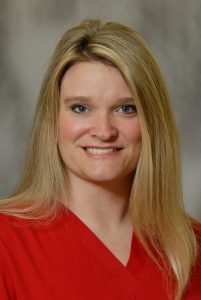 Holly Schifsky OTR/L, CNT, NTMTC, CBIS[/caption]
Holly Schifsky OTR/L, CNT, NTMTC, CBIS[/caption]
We are honored to welcome Holly Schifsky to our faculty and thrilled that she will be presenting her course: Baby Beats and Breaths: Therapeutic Interventions for the Premature Infant with Cardiopulmonary Compromise in 2018.
Having first met her at the 2017 NANT conference, we know that she will be so well received by our community of therapists.
Holly is an Occupational Therapist who has worked in pediatrics for the past 20 years with the past 15 years in a level 4 NICU. She is a Certified Neonatal Therapist, Certified Neonatal Touch and Massage Therapist, Certified Brain Injury therapist, an active member of National Association of Neonatal Therapists, and has completed 6-month mentorship in infant/child NDT. She has worked within the NICU and NICU follow-up clinic to maximize patient and family outcomes for the most complex premature and medically-fragile term infants. Holly received her bachelors degree in Occupational therapy from the University of North Dakota in 1997. She has dedicated her career to clinical care and advancing developmental care practice patterns for all multidisciplinary team members. She has presented at many regional and national conferences including NANT, Audrey Harris Vision NICU conference, and the University of Minnesota NICU conference.
Baby Beats and Breaths: Therapeutic Interventions for the Premature Infant with Cardiopulmonary Compromise
This course will focus on the cardiopulmonary implications for the premature or medically-complex infant as related to physiological stability, evolving motor control, sensory stability, and transition to oral motor skills that support feeding. It will focus on advancing the critical reasoning skills of the neonatal therapist to support the infant’s ability to obtain foundational motor and sensory skills. These skills include the ability of the infant to cough, produce audible phonation, oral motor skills, swallow skills, trunk facilitation, gestational age appropriate positioning/handling to support the emergence of gross motor skills for postural stability. You will learn movement analysis skills (via lab time and video presentations) to assess breathing patterns, facilitation techniques to support trunk development, positioning strategies to support chest wall development, and feeding techniques to maximize postural control.
January 19-20, 2018 – Akron, OH
March 2-3, 2018 – Washington, DC
September 29-30, 2018 – Houston, TX
PLEASE CLICK HERE TO JOIN OUR MAILING LIST
to learn about course relevant to your field coming to your region.
